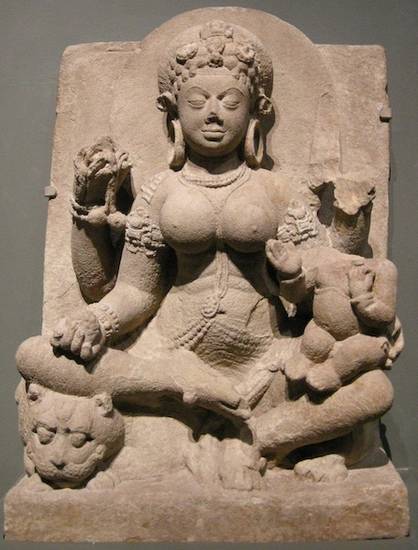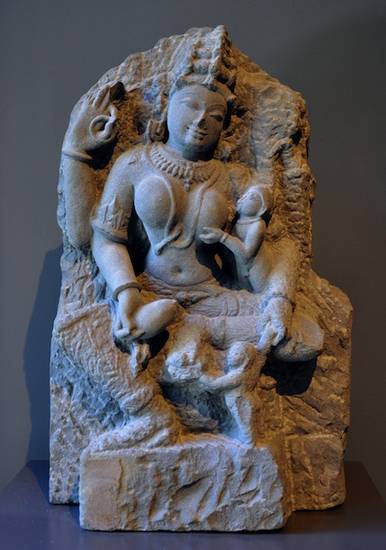Article: Ambikā or Kuṣmāṇḍinī
Ambikā or Kūṣmāṇḍinī is one of the most popular Jain goddesses among Śvetāmbaras and Digambaras alike. She is the yakṣī or female attendant deity of the 22nd Jina, Neminātha or Lord Nemi, but has long been a figure of worship in her own right. As a śāsana-devatā – ‘deity of the teaching’ – she is believed to help protect and spread the message of her Jina. The yakṣa Gomedha is Nemi’s male attendant, but has not developed a similar independent status.
As a goddess, Ambikā or Kūṣmāṇḍinī is a soul subject to the cycle of birth and can intervene in human affairs, unlike Jinas, who are liberated, perfect souls, completely detached from everyday human experience. Lay Jains worship gods partly to request help with worldly matters, ranging from issues of health and fertility, and passing examinations to business success. By the tenth century several of the śāsana-devatās had developed into independent gods at the centre of their own cults. This may be because of their connections with the major Jinas, links with a prominent pilgrimage centre or various stories of their powers.
Śvetāmbaras know her as Ambikā or Kūṣmāṇḍinī while Digambaras call this goddess Kūṣmāṇḍinī. Each sect gives her different attributes, but she is usually presented in art accompanied by a child or two. This underlines her association with motherhood and children, and Jains might worship her when they want to have children.
The numerous temples and images dedicated to Ambikā or Kūṣmāṇḍinī throughout India demonstrate her popularity. However, she has especially close connections with Gujarat, stronghold of Śvetāmbara Jainism, and Shravana Belgola in Karnataka, one of the principal pilgrimage sites for Digambara Jains. Since she is the focus of worship in her own right, she also has hymns and mantras composed for her.
Name
In Sanskrit and north Indian languages the name Ambikā means ‘Mummy’ or ‘Little Mother’. This goddess is closely associated with motherhood and children in legends as well as in her iconography. The name Kūṣmāṇḍinī etymologically means ‘the one associated with a kūṣmāṇḍa’, which is a kind of pumpkin. It is to be noted that a synonym of this, Kūṣṃāṇḍī, is a name of the goddess Durgā in the Hindu tradition. This has led to the assumption that the Jain goddess Ambikā is a borrowed form of Durgā, but this is not accurate.
Rather, Ambikā is connected with a yakṣī named Bahuputrikā – ‘one with many daughters’ – who is said to have been worshipped in old times in Magadha, in eastern India. In Tamil Nadu, Ambikā is also known under the name Dharma-devī – ‘Goddess of the Doctrine’ – which underlines her association with the Jinas.
Roles
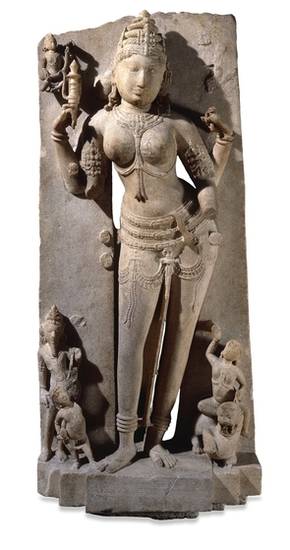
Standing figure of Ambikā
Image by British Museum © Trustees of the British Museum
A powerful deity, Ambikā has several roles. In some respects she can be thought of as the model goddess for the yakṣīs, as the earliest surviving references to these attendant goddesses name her as the sole yakṣī. Her association with the Jina Neminātha or Lord Nemi clearly links her to a function as mother of children and also promotes Jainism as the true religion. One of her most prominent aspects is as protective deity, in particular of children. Kūṣmāṇḍinī is also the guardian divinity of certain holy places, especially Shravana Belgola, the Digambara pilgrimage centre. She demonstrates her appeal to both main Jain sects in her associations with Mount Girnar in Gujarat and is also the presiding deity of a Śvetāmbara sect.
Together with Sarvānubhūti, Ambikā forms the earliest pair of yakṣa and yakṣī in the Jain tradition. These two divinities seem to have provided the model for other yakṣa and yakṣī pairings. The oldest reference to Ambikā in art and literature dates back to the middle of the sixth century CE.
The legend of how Ambikā became the female attendant of the 23rd Jina Nemi does not have a Jain setting, yet is meant to show the final superiority of Jainism over Brahmanism. In the Śvetāmbara tradition, Ambikā is a wife and the mother of two children in Gujarat, with the story clearly set in Saurāṣṭra. Her husband throws her out of the house because she gives food to a Jain monk that had been meant for Hindu Brahmins. She goes to the forest with the children and they sit under a withered mango tree. Miraculously, this mango tree provides fruit and a nearby dried-up lake fills with water so they can survive. When Ambikā’s repentant husband comes to look for them, she misunderstands his intentions and escapes him by jumping in a well with her sons. She is reborn as the yakṣī to Nemi and her husband is reborn as a lion, her vehicle – vāhana – on which Indian deities ride.
The authoritative example for this story is the 14th-century Ambikā-devī-kalpa. It is found in Jinaprabha-sūri‘s Vividha-tīrtha-kalpa, which describes pilgrimage places and Jain beings worthy of worship.
Well-known stories show how Ambikā plays a part in rescuing or aiding devotees. As with other yakṣīs, this help may be extended not only to commoners but also to monarchs. In such cases, therefore, Ambikā acts as the protective deity to a state. For example, it is said that she helped King Kumārapāla accede to the throne in 12th-century Gujarat.
She is also believed to have had a decisive contribution ‘in deciding a dispute between the Śvetāmbaras and Digambaras as to who had authority over the holy place of Girnar’ (Cort 1987: 249) in Gujarat.
In addition Ambikā is the presiding deity of the Kharatara-gaccha. This Śvetāmbara monastic lineage is most numerous in Rajasthan and Gujarat.
Appearance
Both yakṣas and yakṣīs are considered part of the entourage of the Jina image, technically known as parikara. Like all of the attendant deities, Ambikā or Kūṣmāṇḍinī has certain features that help to identify her and indicate her powers. These are described in, for example, texts on the iconography of the Jina, which outline the appearance of the Jina’s attendants.
Being presented as a deity implies that Ambikā has special characteristics linked to the depiction of gods in art. This means she:
- may have more than two arms or hands
- has a vehicle – vāhana
- demonstrates attributes by holding various objects
- may exhibit hand-gestures that symbolise a concept or attitude – mudrās.
Both the principal Jain sects associate Ambikā with motherhood and give her a lion as her divine mount or vehicle. This indicates her possible connection with Ambājī, a popular Hindu goddess in Gujarat (Cort 1987: 248).
However, Śvetāmbara and Digambara Jains view her appearance differently.
Ambikā is identifiable in Śvetāmbara art from the presence of one child on her hip with the other by her side, or accompanied by one child only. The lion vehicle is also often there, as well as a mango tree or bunch of mangoes. Other features have changed in the course of time but common characteristics in Śvetāmbara depictions of Ambikā include the noose and goad. Such weapon-like attributes characterise several yakṣīs and are meant to show that they are powerful beings. Their presence has been interpreted as a sign of the Śakti cult, which was widespread in India, especially between the tenth and 13th centuries.
The standard description by the 12th-century author Hemacandra states:
A Kuṣmāṇḍī, named Ambikā, originating in the congregation [of Lord Nemi], gold color, with a lion for a vehicle, holding in two right hands a bunch of mangoes and a noose; and in her two left hands a boy and a goad, became the Lord’s messenger-deity.
Triṣaṣṭiśalākāpuruṣacaritra VIII.9.384
Johnson’s translation, volume 5, page 273
Jinaprabha-sūri’s 14th-century piece on Ambikā says the same.
As a deity, Ambikā is often portrayed with more than two arms, ranging from four or eight to many arms. The only surviving figures of Ambikā that date from up to the end of the ninth century take the two-armed form, then evidence of the multi-armed form goes on increasing. Among Digambaras, however, Kūṣmāṇḍinī is presented with two arms. The sects also give her varying divine attributes, which she holds in her hands. Thus the number of attributes and arms are connected when she is represented in art.
Images
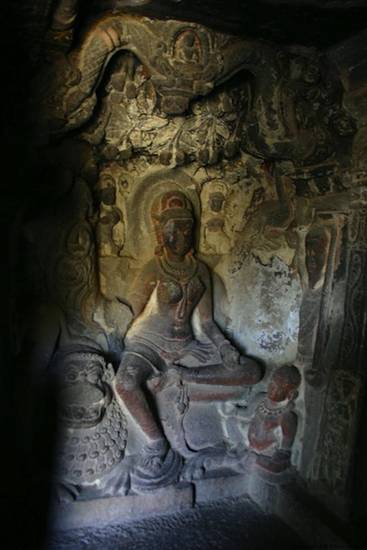
Ambikā figure in Ellora
Image by Y. Shishido © CC BY-SA 3.0
Among the earliest images of Ambikā are Akota bronzes from the late sixth century but these are rare. The two-armed goddess is the standard from the eighth to the 12th centuries whereas the four-armed or multi-armed forms become more common until the 16th century (Tiwari 1989: 26ff.)
Numerous images of Ambikā are available as independent sculptures or in temples of both Śvetāmbaras and Digambaras, all over India. Among the most famous ones are the figures in:
- the Ellora Caves 32 and 33, carved in the ninth century
- the Gujarati temples of Kumbharia, dated to 1062 CE
- the temples of Mount Abu in Rajasthan and Taranga in Gujarat, which both date from the 12th century
- Madhya Pradesh, especially in well-known Jain sites such as Deogarh (Bruhn 1969: 77ff.), Khajuraho, Canderi and Vidisha, which date back to the ninth to tenth centuries.
Plenty of images of Ambikā created from the ninth century onwards survive in Bihar, Bengal, Orissa, Tamil Nadu and Karnatak.
A fierce form of Ambikā is also worshipped in Tantric rites.
The 14th-century Śvetāmbara author Jinaprabha-sūri refers to images of Ambikā at several Jain holy places in northern and western India. He also states that Ambikā was the guardian deity of Mathurā. Figures of the goddess from the eighth to ninth century are available (Tiwari and Sinha 2011: 108).
Temples
As a favourite Jain goddess, Ambikā has numerous temples dedicated to her. Tiwari gives some examples (1989: 145–146) of the many found throughout India.
One temple to Ambikā was constructed in the tenth to 11th century near Thān in Saurashtra, Gujarat.
An image of Ambikā in the Allahabad Museum in Uttar Pradesh is supposed to have been originally installed in the cella of the Patiān-dāi temple in the Satna district of Madhya Pradesh.
In south India too, there are many independent shrines dedicated to Ambikā. An example is the one to the south of the Vardhamāna temple at Tirupparuttikkunram in Tamil Nadu.
Girnar
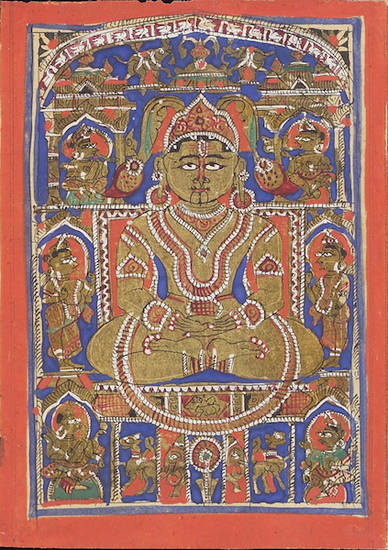
Lord Nemi and attendants
Image by Wellcome Trust Library © Wellcome Library, London
There is a privileged association between this goddess and the holy place of Mount Girnar, in Gujarat. Ambikā is the yakṣī of the 22nd Jina, Neminātha or Lord Nemi, who is closely connected to this place because it is where he reached final liberation from the cycle of rebirths.
The Digambara temple to Kūṣmāṇḍinī at Mount Girnar dates back to the mid-eighth century CE. Textual evidence from the 14th century testifies to pilgrimages that various Jain dignitaries made to the temple on the mountaintop, and enables phases in the temple‘s development and history to be traced.
The 14th-century account of Ambikā’s legend by Jinaprabha-sūri, a Śvetāmbara monk, shows that her presence and cult at Girnar, in association with Nemi, was acknowledged beyond sectarian divisions. In this piece the author calls the goddess both Ambiā – Prakrit for Ambikā – and Kohaṇḍidevi – Prakrit for Kūṣmāṇḍinī – using both forms of her name. He clearly states that she resides at the top of the hill, as the śāsana-devatā of Nemi.
Shravana Belgola
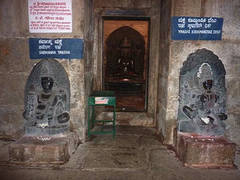
Sarvānubhūti and Kūṣmāṇḍinī
Image by Nalini Balbir © Nalini Balbir
In Karnatak, Ambikā is mostly known under the name Kūṣmāṇḍinī. There is evidence of her status as an independent deity in this region in the seventh century. She is the guardian deity of Shravana Belgola, the Digambara centre of pilgrimage.
The reasons for her connection with this holy place are not clear. For example, there is no temple in Shravana Belgola dedicated to Neminātha or Lord Nemi, the Jina with whom she is associated.
There is no mythic or iconographic connection between her and Bāhubali [the Jain saint closely associated with the site]. Her role as guardian of the shrine, therefore, either precedes the consecration of the Bāhubali icon in 981 A.D., or else further shows how the cults of the Jain goddesses in Karnataka are only loosely tied to those of the Jinas
Cort 2010: 348
There are several figures of Kūṣmāṇḍinī at Shravana Belgola, namely those in:
- a cell in the temple to the eighth Jina, Candraprabha, in the village, next to the maṭha – seat of the bhaṭṭāraka
- a cell in the pavilion behind the Bāhubali image on the large hill, Vindhya-giri
- the Kattale Basadi, on the smaller hill of Candra-giri.
They are not prominent or large, and Kūṣmāṇḍinī is featured among other deities. But these images are the focus of sustained devotional activity.
Worship

Goddess Ambikā
Image by Shanammumbai © CC BY-SA 3.0
A variety of hymns praising Ambikā on her own have been composed in all the languages Jains have used. A noteworthy one is the stavana composed in Sanskrit by the famous Gujarati minister Vastupāla in the 13th century (Nawab 1937/1996 and Jhavery 1944: 328–329).
This deity is said to fulfil all the desires of right-believers and to remove all obstacles.
The 14th-century author Jinaprabha-sūri explains how all sorts of successes and powers will come to Jain believers who worship her using dedicated mantras, yantras and so on. He describes how they will get all sorts of wealth, children, wives and friends, and how they will not come under the power of all sorts of demonic influences. Ambikā, like other yakṣīs or female goddesses, is thus ascribed protective powers.
Ambikā’s connection with motherhood means that worship of her may be performed to request her protection for children. A 14th-century manual on the Jain lay man’s daily conduct, the Ācāradinakara, indicates that ‘a prayer to the goddess Ambikā to guard the child’ (Williams 1963: 279) is part of the birth ceremony. Taking place shortly after a baby is born, this ritual is intended to protect the infant and keep it healthy.
Tantric rituals
Worship of Ambikā is often done the Tantric way – the deity is invoked under several different names and visualised with the help of mantras to meditate.
At the end of the piece he writes to praise Ambikā, Jinaprabha gives a few mantras. He indicates that there are many more which he skips over so as not to make his work too big, but which can be learnt from one’s own teacher. They are worth remembering, he says, to ensure the protection of oneself and of others as well.
Various rites are performed with the help of yantras to appease evil forces and placate the goddess. Some of the names used for her may point to her destructive capacities if she is not properly worshipped. This is a way to gain her good will. Besides propitiatory rites, there are also gruesome ceremonies that suggest the terrifying form of the deity is visualised.
Such mantras and rites are given in hymns or in texts called kalpas, written in Sanskrit. These texts set out rituals and yantras for efficient and successful worship. Such works dedicated to Ambikā are available from the 12th century onwards. Examples are:
- the Ambikāṣṭaka of Ambāprasāda, written around the 12th century CE
- Jineśvara-sūri’s 12th-century Ambikā-devī-stuti
- the Ambikātāḍaṃka, the Ambikātāṭaṃka and the Ambikā-stuti, all written between the 12th and 14th centuries (Tiwari 1989: page 29ff. with original Sanskrit texts on pages 148 to 153; Nawab 1937/1996: 175–181 and Jhavery 1944: 322–330).
When successful in their worship, the devotees have all their desires fulfilled. In the Ambikātāḍaṃka, it is clearly stated that worshipping Ambikā ensures that they will get children.
Reading
- The Jaina Iconography
B. C. Bhattacharya - Motilal Banarsidass; Delhi, Varanasi, Uttar Pradesh and Patna, Bihar in India; 1974
- ‘The Goddesses of Sravana Belgola’
John E. Cort - Svasti – essays in honour of Prof. Hampa Nagarajaiah for his 75th Birthday
edited by Nalini Balbir
Muddushree Granthamala series; volume 75
K. S. Muddappa Smaraka Trust; Bangalore, Karnataka, India; 2010
- Śrī Kuṣmāṇḍinī Devī: Śravaṇa Belgola
Vidyullatā Vidyādhar Deśmāne - Shri Kailascandra A. Randive; Mumbai, Maharashtra, India; 1987
- The Jains
Paul Dundas - Library of Religious Beliefs and Practices series; series editor John Hinnels and Ninian Smart; volume 14
Routledge Curzon Press; London, UK; 2002
- ‘Some Thoughts on the Identification of Jaina Images in Tamilnadu’
A. Ekambaranathan - Svasti – essays in honour of Prof. Hampa Nagarajaiah for his 75th Birthday
edited by Nalini Balbir
Muddushree Granthamala series; volume 75
K. S. Muddappa Smaraka Trust; Bangalore, Karnatak, India; 2010
- Life in Ancient India as depicted in Jaina Canon and Commentaries: 6th Century BC to 17th Century AD
Jagdischchandra Jain - Munshiram Manoharlal; Delhi, India; 1984
- Comparative and Critical Study of Mantrashastra (With Special Treatment of Jain Mantravada): Being The Introduction to Sri Bhairava Padmavati Kalpa
Mohanlal Bhagwandas Jhavery - Sri jain kala sahitya samsodhak (Jain Art Publication) series; volume 1
Sarabhai Manilal Nawab; Ahmedabad, Gujarat, India; 1944
- Vividhatīrthakalpa
Jinaprabhasūri - edited by Muni Jinavijaya
Singhi Jain series; volume 10
Shantiniketan; Bombay, India; 1934
- Vividha Kalpa Saṃgraha: Mul, gujarātī bhāṣāntara, mantra-yantra-tantra no saṃgraha pariśiṣṭo sāthe
Nawab Sarabhai Manilal and Nawab Rajendra Sarabhai - Śrī Jaina kalā sāhitya saṃśodhana granthamālā series; volume 22
Amadāvāda; Ahmedabad, Gujarat, India; 1998
- Śrī Bhairavapadmāvatīkalpa: śrīBandhuṣeṇa nī vistṛta ṭīkā tathā śuddha mantragarbhita 31 pariśiṣṭo sahita [aneka yantrakṛtio sāthe] dvitīya saṃvṛddhita āvṛtti [ādya sampādaka Sva. Prof. K.V. Abhyankar]
Malliṣeṇasūriviracita - Nawab Sarabhai Manilal; Ahmedabad, Gujarat, India; 1996
- Padmāvatī ādi śāsana devoṃ kā astitva hī nahīṃ
Viradhīlāl Seṭhī - Jain Saṃskr̥ti Saṃrakṣaṇ Samiti
- The Jain Saga: 63 Illustrious Persons of the Jain World, Brief History of Jainism
Hemacandra - translated by Helen M. Johnson
edited by Muni Samvegayashvijayji Maharaj
Acharya Shrimad Vijay Ramchandra Suriswarji Jain Pathshala; Ahmedabad, Gujarat and Mumbai, Maharashtra, India; 2009
- Jaina Yoga: A Survey of the Mediaeval Śrāvakācāras
Robert Williams - London Oriental series; volume XIV
Oxford University Press; London, UK; 1963
- The Concept of Divinity in Jainism
Robert J. Zydenbos - Centre for South Asian Studies of the University of Toronto; Toronto, Canada; 1993
- ‘Göttinverehrung im Jainismus’
Robert J. Zydenbos - Aspekte der Weiblichen in der indischen Kultur
edited by Ulrike Roesler
Indica et Tibetica series; volume 39
Indica et Tibetica; Swisttal-Odendorf, North-Rhine-Westphalia, Germany; 2000
Links
- Ambikā
-
Image of Ambikā or Kūṣmāṇḍinī from Uttar Pradesh. A very popular goddess associated with motherhood and children, Ambikā is usually depicted holding a mango and with a child, her lion vehicle nearby. She is also the female attendant deity – yakṣī – of the 22nd Jina Nemi, whose smaller figure sits above her. This zoomable photograph is on the website of the Norton Simon Museum in Pasadena, California, USA.
http://www.nortonsimon.org/collections/browse_title.php?id=P.2004.01.1
- Damaged sculpture of Ambikā
-
Damaged stone figure of Ambikā or Kūṣmāṇḍinī, the Jain goddess associated with children and motherhood. A smaller image of the 22nd Jina Nemi sits in her headdress. Ambikā is his female attendant deity – yakṣī. The auction house Christie's provides notes and a zoomable photograph of the sculpture.
- Kūṣmāṇḍinī at Shravana Belgola
-
Flickr image from 2009 of the goddess Kūṣmāṇḍinī at Shravana Belgola, Karnataka. The powerful goddess is the guardian divinity of this major Digambara pilgrimage centre, although she is popular among all Jain sects. She is the female attendant deity – yakṣī – of the 22nd Jina Nemi and is associated with motherhood and children. Her left foot rests on her divine vehicle of a lion, which is straddled by two small figures, probably representing her sons. She is known as Ambikā to Śvetāmbara Jains.
- Decorated figure of Kūṣmāṇḍinī
-
Free-standing stone sculpture of the goddess Kūṣmāṇḍinī or Ambikā in Shravana Belgola. She is the guardian deity of this Digambara holy place in Karnataka. This 2006 photograph on Flickr shows the statue draped with garlands of flower offerings. Kūṣmāṇḍinī is worshipped all over India and among the Jain diaspora for her associations with fertility and children, and for her protective powers. She is also the female attendant deity – yakṣī – of the 22nd Jina Nemi.
- Kūṣmāṇḍinī at Ellora
-
A damaged figure of the yakṣī Kūṣmāṇḍinī or Ambikā beneath a mango tree in cave 32 of the Ellora temple complex in Maharashtra. Attended by servants, the Digambara statue wears an elaborate headdress and jewellery, and sits on her lion vehicle. Only half of the image of the small child sitting on her thigh has survived. This zoomable photograph is part of the Beyond the Taj: Architectural Traditions and Landscape Experience in South Asia project at Cornell University Library in the USA.
- Figure of Ambikā or Kūṣmāṇḍinī
-
Sculpture on Flickr of the goddess Ambikā or Kūṣmāṇḍinī in the Rani Durgavati Museum, Jabalpur, in Madhya Pradesh. She is the yakṣī – female attendant deity – of the 22nd Jina Nemi, and is a protective goddess connected with children and fertility. The jewellery-bedecked statue was probably originally holding a small child on her left knee, though this part has been badly damaged.
- Possible statue of Ambika
-
This figure from Bihar, with an elaborate headdress, may be the goddess Ambika or Kūṣmāṇḍinī, who is associated with children and fertility. She is conventionally portrayed holding a mango and accompanied by a small child or two. She is also the yakṣī – female attendant deity – of Nemi, the 22nd Jina. This photograph is on the website of the Asian Art Museum in San Francisco, California, USA.
http://67.52.109.59:8080/emuseum/view/objects/asitem/id/19199
- Nemi and his entourage
-
A 12th-century metal shrine of the 22nd Jina Neminātha, or Lord Nemi, and his retinue, surrounded by other Jinas. At the bottom on either side sit his male attendant deity – yakṣa – Gomedha and his female attendant deity – yakṣī – Ambikā. The auction house Christie's, which sold this item in 2007, provides notes and views of the shrine's front and back.
http://www.christies.com/lotfinder/lot/a-bronze-jain-shrine-india-gujarat-dated-4879315-details.aspx
- Nemi and attendants
-
A 11th-century marble image of the 22nd Jina Neminātha or Lord Nemi and his attendants. Decorated elephants flank the royal canopy over the Jina, who is fanned by servants on both sides. At the bottom on either side sit his male attendant deity – yakṣa – Gomedha and his female attendant deity – yakṣī – Ambikā. This zoomable photograph is on the website of the Norton Simon Museum in Pasadena, California, USA.
http://www.nortonsimon.org/collections/browse_title.php?id=F.1978.28.S
- Lord Nemi and his retinue
-
Bronze shrine featuring the 22nd Jina, Nemi, and attendants. Attributes of high status are clear, such as the triple canopy, the lion throne and the servants. His spiritual supremacy is signalled by the nimbus around his head, his lotus pose of meditation, the śrīvatsa on his chest and the meditating Jinas on both sides. At the bottom on either side sit his male attendant deity – yakṣa – Gomedha and his female attendant deity – yakṣī – Ambikā. This zoomable photograph is on the website of the Norton Simon Museum in Pasadena, California, USA.
http://www.nortonsimon.org/collections/browse_title.php?id=F.1975.17.23.S
- Jina and attendant deities
-
Seventh-century bronze image of a Jina and his attendant śāsana-devatās – ‘deities of the teaching’ – who protect and promote his teaching. Identified as the 22nd Jina Neminātha or Lord Nemi, this figure is deep in meditation. Nemi's yakṣa – male attendant deity to a Jina – is called Gomedha while his yakṣī – female attendant deity – is known as Ambikā or Kūṣmāṇḍinī. This rare early representation of a Jina is available to view on the website of the Metropolitan Museum of Art in New York, USA.
http://www.metmuseum.org/Collections/search-the-collections/60048796
- +
- aAbhavya
- aAbhinandana
- aAbhiṣeka
- aĀcāra
- aĀcārāṅga-sūtra
- aĀcārya
- aAchalbhrata
- aAḍhāī-dvīpa
- aAdharma
- aAdho-loka
- aAdhyayana
- aAdvaita Vedānta
- aĀgama
- aAghātīya
- aAghātīya-karman
- aAgnibhuti
- aAgra
- aĀhāra
- aAhiṃsā
- aAhimsa Day
- aAjita
- aAjīva
- aAkampit
- aĀkāśa
- aAkbar the Great
- aAkṣaya-tṛtīyā
- aAlauddin Khalji
- aAlbert Einstein
- aAllah
- aAlms
- aĀlocanā
- aAloka-ākāśa
- aAmāri
- aAmbikā or Kūṣmāṇḍinī
- aAnagāra
- aAnanta
- aAnarthadaṇḍa
- aAnaśana
- aAnekānta-vāda
- aAṅga
- aAniconism
- aAnojjā
- aAntarāla
- aAntarāya-karma
- aAṇu
- aAṇu-vrata
- aAnukampā
- aAnuprekṣā
- aAnusvāra
- aApabhraṃśa
- aAparigraha
- aAra
- aĀrambha
- aĀrambhaja
- aĀratī
- aArdhamāgadhī Prākrit
- aArhaṃ
- aArhat
- aArśana-āvaraṇīya-karma
- aĀrta-dhyāna
- aĀryikā
- aĀryikā Jñānamati
- aĀśātanā
- aĀścarya
- aAscetic
- aAsceticism
- aAshram
- aAspiration
- aĀsrava
- aAṣṭa-maṅgala
- aAṣṭāpada
- aAstikāya
- aAstrolabe
- aAsura
- aAtheism
- aAticāra
- aAtiśayakṣetra
- aAtithisaṃvibhāgavrata
- aĀtma-vāda
- aĀtman
- aAuṃ
- aAurangzeb
- aAuspicious
- aAusterity
- aAvadhāna
- aAvadhi-jñāna
- aĀvaraṇī-yakarman
- aAvasarpiṇī
- aAvatāra
- aAvidyā
- aAxiom
- aĀyāga-paṭa
- aĀyambil
- aĀyu-karma
- aĀyurveda
- bBabur
- bBāhubali
- bBaladeva
- bBālāvabodha
- bBandha
- bBasadi
- bBazaar
- bBhadrankarvijay
- bBhagavant
- bBhaktāmara-stotra
- bBhakti
- bBhale
- bBharata
- bBhāṣā
- bBhāṣya
- bBhaṭṭāraka
- bBhāva
- bBhāva-pūjā
- bBhāvanā
- bBhavana-vāsin
- bBhavya
- bBhavyatva
- bBhaya
- bBhoga-bhūmi
- bBhogopabhoga
- bBodhi
- bBollywood
- bBrahmā
- bBrahma-deva
- bBrahmacārī
- bBrāhmaṇa
- bBraj Bhāṣā
- bBright fortnight
- bBritish Raj
- bBuddha
- bBuddhi-sagar
- bBuddhism
- bBuddhist
- cCaitya
- cCaityavāsin
- cCakravartin
- cCakreśvarī
- cCāmara
- cCandanā
- cCandragupta
- cCandraprabha
- cCanon
- cCāritra
- cCāritramohanīya-karman
- cCarũrī
- cCaste
- cCaturvidha-saṅgha
- cCaturviṃśati-stava
- cCāturyāma
- cCE
- cCelibacy
- cCha
- cChadmastha
- cChastity
- cCheda-sūtra
- cChristian
- cChristianity
- cClergy
- cCloning
- cColophon
- cCommentary
- cConch
- cConfession
- cCongregation
- cConsecration
- cCosmology
- cCremation
- cCrore
- cCult
- cCūrṇi
- dDādā-guru
- dDalit
- dDāna
- dDaṇḍa
- dDark fortnight
- dDarśana
- dDarśanamohanī-yakarman
- dDaśa-lakṣaṇa-parvan
- dDeity
- dDelhi Sultanate
- dDerāsar
- dDeśāvakāśika-vrata
- dDetachment
- dDevanāgarī
- dDevānandā
- dDevarddhi-gani
- dDevotee
- dDhamal
- dDhanuṣ
- dDhāra
- dDharma
- dDharma-dhyāna
- dDharma-sāgara
- dDharmastikaya
- dDhātakīkhaṇḍa
- dDholak
- dDhyāna
- dDiaspora
- dDig-vrata
- dDigambara
- dDīkṣā
- dDisciple
- dDīvālī
- dDivya-dhvani
- dDNA
- dDoctrine
- dDogma
- dDonor
- dDoṣa
- dDravya
- dDravya-pūjā
- dDrone
- dDuṣamā
- dDuṣamā-duṣamā
- dDuṣamā-suṣamā
- dDveṣa
- dDvīpa
- eEast India Company
- eEightfold Path
- eEkānta-vāda
- eEkendriya
- eElder
- eElders
- eEschatology
- eEtc up to
- fFarmān
- fFast
- fFatehpur Sikri
- fFestival
- fFestschrift
- fFiruz Shah
- fFly-Whisks
- fFolio
- fFour Noble Truths
- gGaccha
- gGaṇa
- gGaṇadhara
- gGanadharavada
- gGaṇeśa
- gGaṇin
- gGarba
- gGarbha
- gGarbha-gṛha
- gGaruḍa
- gGati
- gGene
- gGenomics
- gGhātī-yakarman
- gGhātīya
- gGhaznavid
- gGhiyasuddin Tughlaq
- gGhurid
- gGloss
- gGotra-karma
- gGujarāt
- gGujarati
- gGuṇa
- gGuṇa-sthāna
- gGuṇa-vrata
- gGupti
- gGuru
- gGuruṇī
- hHagiography
- hHajj
- hHaṃsa
- hHaribhadra
- hHariṇaigameṣin
- hHasta
- hHeresy
- hHiṃsā
- hHindi
- hHindu
- hHinduism
- hHīravijaya
- hHoroscope
- hHrīṃ
- hHumayun
- hHymn
- iIconoclasm
- iIconography
- iIdol
- iIndian Independence
- iIndology
- iIndra
- iIndrabhūti Gautama
- iIndriya
- iInitiation
- iIntercession
- iInvocation
- iIQ
- iIslam
- iIslamicate
- iIṣṭadevatā
- iĪśvara
- jJagat
- jJahangir
- jJain
- jJaina Devanāgarī
- jJaina Śaurasenī
- jJaina-dharma
- jJainaśāsana
- jJainness
- jJaisalmer
- jJamāli
- jJambū-dvīpa
- jJames Burgess
- jJanma
- jJanma-kalyāṇa
- jJarā
- jJāti
- jJina
- jJina-āgama
- jJina-bhavana
- jJina-bimba
- jJina-mātā
- jJinacandra-sūri
- jJinadatta
- jJinaprabha
- jJīva
- jJñāna
- jJñāna-āvaraṇīya-karma
- jJñāna-āvarṇiya
- jJñānsundar
- jJyotiṣka
- kKāla
- kKālakācārya-kathā
- kKālidāsa
- kKalpa-sūtra
- kKalpa-vṛkṣa
- kKalyāṇaka
- kKalyanvijay
- kKamaṇḍalu
- kKamaṭha
- kKarma
- kKarma-bhūmi
- kKarma-grantha
- kKarma-prakṛti
- kKarma-vāda
- kKarmon
- kKarnataka
- kKaṣāya
- kKathā
- kKāvya
- kKāya
- kKāyotsarga
- kKeśa-loca
- kKetu
- kKevala-jñāna
- kKevalin
- kKhalji
- kKharatara-gaccha
- kKnowledge
- kKriyā
- kKriyā-vāda
- kKṛṣṇa
- kKṣamā-śramaṇa
- kKṣapakaśreṇi
- kKṣatriya
- kKṣullaka
- kKulakara
- kKundakunda
- kKunthu
- lLabdhi
- lLaity
- lLakh
- lLāñchana
- lLands of Action
- lLaukāntika
- lLavaṇa-samudra
- lLeśyā
- lLiṅga
- lLinguistics
- lLoka
- lLoka-ākāśa
- lLoka-puruṣa
- lLoka-vāda
- lLotus
- lLotus lake
- mMadhya-loka
- mMahā-videha
- mMahā-vrata
- mMahābhārata
- mMahāmastakābhiṣeka
- mMāhārāṣṭra
- mMāhārāṣṭrī Prākrit
- mMahattarā Yākinī
- mMahāvīr Jayantī
- mMahāvīra
- mMakāra
- mMakkhali Gośāla
- mMalli
- mMāna-stambha
- mManaḥ-paryāya-jñāna
- mMaṇḍala
- mMaṇḍapa
- mMandit
- mMaṅgala
- mMantra
- mMantras
- mManuṣya-loka
- mMarāṭhī
- mMārgaṇā
- mMartyr
- mMarudevī
- mMaṭha
- mMati-jñāna
- mMauryaputra
- mMecca
- mMendicant lineage
- mMetarya
- mMiracle
- mMithyādṛṣṭi
- mMohandas Gandhi
- mMohanīya-karma
- mMokṣa
- mMonastic order
- mMonasticism
- mMonk
- mMonotheism
- mMosque
- mMount Meru
- mMount Sammeta
- mMṛgāvatī
- mMughal
- mMuhammad
- mMuhammad bin Tughlaq
- mMuhpattī
- mMūla-sūtra
- mMūlaguṇa
- mMumbaī
- mMuni
- mMunisuvrata
- mMurad Bakhsh
- mMūrti-pūjaka
- mMuslim
- mMysticism
- nNābhi
- nNāga-kal
- nNāgapurīya Tapā-gaccha
- nNāgarī
- nNāma-karma
- nNamaskāra-mantra
- nNami
- nNandīśvara-dvīpa
- nNandivardhana
- nNandyāvarta
- nNāraka
- nNāraki
- nNasalisation
- nNātha
- nNavrātrī
- nNaya-vāda
- nNemi
- nNidāna
- nniggaṃthāṇa vā 2
- nniggaṃtho vā 2
- nNigoda
- nNihnava
- nNikṣepa
- nNirgrantha
- nNirjarā
- nNirvāṇa
- nNiryukti
- nNiṣidhi
- nNitya
- nNiyati
- nNo-kaṣāya
- nNudity
- nNun
- oOcean of milk
- oOmniscience
- oOrdination
- ppa°
- pPadmaprabha
- pPadmāsana
- pPadmāvatī
- pPādukā
- pPalanquin
- pPalette
- pPañca-muṣṭi
- pPāṇḍava
- pPaṇḍit
- pPandit Dalsukh D. Malvania
- pPandit Sukhlalji
- pPāṇipātra
- pPāpa
- pParamātman
- pParameṣṭhin
- pPāraṇā
- pParigraha
- pPariṇāma
- pParīṣaha
- pParokṣa
- pPārśva
- pPārśvanātha
- pParyāya
- pParyuṣaṇ
- pPaṭa
- pPatan
- pPātra
- pPenance
- pPersian
- pPhala
- pPhilology
- pPicchikā
- pPilgrimage
- pPīr
- pPolymath
- pPoṣadha
- pPossession
- pPothī
- pPrabhas
- pPradakṣiṇā
- pPradeśa
- pPrākāra
- pPrakīrṇaka-sūtra
- pPrākrit
- pPramāda
- pPramukhā
- pPrati-vāsudeva
- pPratikramaṇa
- pPratimā
- pPratiṣṭhā
- pPratyākhyāna
- pPratyakṣa
- pPravacana
- pPrāyaścitta
- pPrayer
- pPre-modern
- pPreach
- pPredestination
- pProtestant
- pProvenance
- pPudgala
- pPūjā
- pPujārī
- pPukharavara-dvīpa
- pPuṇya
- pPūrva
- pPuṣkara-dvīpa
- pPuṣpadanta
- pPyre
- qQur’an
- rRāga
- rRāhu
- rRainy season
- rRajasthan
- rRajasthani
- rRājimatī
- rRajoharaṇa
- rRajput
- rRāma
- rRāmāyaṇa
- rRangoli
- rRās-garbā
- rRasa
- rRathanemi
- rRatna-traya
- rRātri-bhojana
- rRaudra-dhyāna
- rRecto
- rRelic
- rRenunciation
- rRetroflex
- rRevatī
- %Ṛg-veda
- rRite
- rRosary
- %Ṛṣabha
- %Ṛṣabhanātha
- rRupee
- sSaciyā Mātā
- sSādhu
- sSādhvī
- sSāgāra
- sSaint
- sŚaivaism
- sŚaka-saṃvat
- sSallekhanā
- sŚalya
- sSamacatuṣṭha
- sSamādhimaraṇa
- sSamaṇi
- sSāmarambha
- sSamavasaraṇa
- sSāmāyika
- sSaṃbhava
- sSamiti
- sSaṃjñā
- sSaṃkalpaja
- sSaṃsāra
- sSamudghāta
- sSaṃvara
- sSaṃvega
- sSamyak-cāritra
- sSamyak-darśana
- sSamyak-jñāna
- sSamyaktva
- sSaṃyama
- sSanctuary
- sSandalwood
- sSaṇgha
- sSanskrit
- sSant
- sŚānti
- sSapta-bhaṅgi-naya
- sSārambha
- sSarasvatī
- sSarvajña
- sSāsan-devi
- sŚāsana-devatā
- sŚāstra
- %Ṣaṭ-jīvanikāya
- sSatī
- sSatīmātā
- sSatya
- sSchism
- sScribe
- sScripture
- sSect
- sSecularism
- sŚenāī
- sSermon
- sŚeṣavatī
- sSevā
- sSeven fields of donation
- sShah Jahan
- sShantidas Jhaveri
- sShrine
- sSiddha
- sSiddha-śilā
- sSiddhacakra or Navadevatā
- sSiddhānta
- sSiddhārtha
- sSiddhi
- sSikh
- sSikhism
- sŚikṣā-vrata
- sŚīla
- sSin
- sSindh
- sŚītala
- sŚiva
- sSkandha
- sSomanatha
- sŚraddhā
- sŚramaṇa
- sŚrāvaka
- sŚrāvakācāra
- sŚrāvikā
- sŚreyāṃsa
- sŚrī
- sŚrīvatsa
- sŚruta-jñāna
- sŚruta-pañcamī
- sSthānaka-vāsin
- sSthāpanācārya
- sSthāvara
- sSthavira
- sSthiti
- sStrīmukti
- sStūpa
- sSubcontinent
- sSudarshana
- sŚuddhi
- sSudharma
- sŚūdra
- sSufism
- sSukha
- sŚukla-dhyāna
- sSulasā
- sSultan
- sSumati
- sSundarśrī
- sSupārśva
- sSūri
- sSuṣamā
- sSuṣamā-duṣamā
- sSuṣamā-suṣamā
- sSūtra
- sSuyam me ausam! Tenam bhagavaya evamakkhayam
- sSvādhyāya
- sSvāhā
- sSvastika
- sŚvetāmbara
- sŚvetāmbara Terāpanthin
- sŚvetāmbaras
- sSwan
- sSyād-vāda
- tTabla
- tTantra
- tTapā-gaccha
- tTapas
- tTāraṇ Svāmī Panth
- tTattva
- tTattvārtha-sūtra
- tTemple
- tTemple-city
- tThe Enlightenment
- tTheology
- tThree worlds
- %Ṭīkā
- tTilaka
- tTīrtha
- tTīrthaṃkaranāma-karman
- tTīrthankara
- tTransliteration
- tTrasa
- tTrasa-nāḍī
- tTriśalā
- tTriṣaṣṭi-śalākā-puruṣa-caritra
- tTti bemi
- tTughlaq
- tTunk
- uUdumbara
- uUniversal History
- uUpādhyāya
- uUpāṅga
- uUpaniṣads
- uUpāsaka
- uUpasarga
- uUpāśraya
- uŪrdhva-loka
- uUtsarpiṇī
- uUttarādhyayana-sūtra
- vVāhana
- vVaimānika
- vVairāgya
- vVaiṣṇava
- vVaiśramaṇa
- vVaiśya
- vValabhī
- vVanaspatikāya
- vVandana
- vVaṇik
- vVarṇa
- vVāsudeva
- vVāsupūjya
- vVayubhūti
- vVeda
- vVedanīya-karma
- vVegetarianism
- vVehicle
- vVernacular
- vVerso
- vVidyā
- vVidyā-devī
- vVihāra
- vVijñapti-patra
- vVikrama-saṃvat
- vVikṛti
- vVimala
- vVinaya
- vVipāka
- vVirji Vora
- vVirodhaja
- vVīrya
- vVisarga
- vViṣṇu
- vVītarāga
- vVizier
- vVotive
- vVow
- vVrata
- vVS
- vVyakta
- vVyantara
- vVyasana
- yYakṣa
- yYakṣī
- yYantra
- yYaśoda
- yYaśovijaya
- yYati
- yYātrā
- yYoga
- yYoginī
- yYojana



